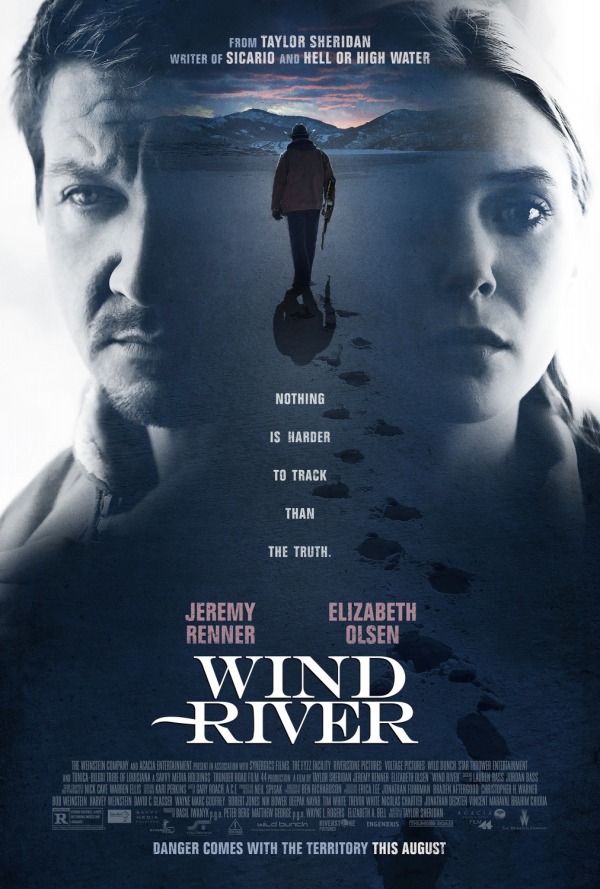WIND RIVER (Directed by Taylor Sheridan, USA, 2017, 107 minutes)
 BY CHRISTOPHER MALENEY FILM CRITIC In the more militaristic branches of American culture, there is a belief that society can be broken down into three categories of people: sheep, sheepdogs, and wolves. The sheep are ordinary people who go about their lives with no understanding for the world’s dangers. The wolves are anyone who preys on the weak and takes whatever they want. The only line of defense between the sheep and the wolves are the sheepdogs, protectors of the flock who tirelessly hunt down bad guys and never ask for praise. Anyone with half a brain for historic materialism might point out the flaws in this theory, but militarism is largely unconcerned with such trifles. Wind River, which will probably go down as one of the best murder mysteries of the year, makes use of this social theory, but not in a familiar way.
BY CHRISTOPHER MALENEY FILM CRITIC In the more militaristic branches of American culture, there is a belief that society can be broken down into three categories of people: sheep, sheepdogs, and wolves. The sheep are ordinary people who go about their lives with no understanding for the world’s dangers. The wolves are anyone who preys on the weak and takes whatever they want. The only line of defense between the sheep and the wolves are the sheepdogs, protectors of the flock who tirelessly hunt down bad guys and never ask for praise. Anyone with half a brain for historic materialism might point out the flaws in this theory, but militarism is largely unconcerned with such trifles. Wind River, which will probably go down as one of the best murder mysteries of the year, makes use of this social theory, but not in a familiar way.
Cory Lambert (Jeremy Renner), is a tracker for the Fish and Wildlife services who hunts predators. His introductory scene, protecting a herd of goats from a pack of wolves, shows us his place as a ‘sheepdog.’ However, instead of a condescending protector of helpless communities, Cory’s motivation is personal. His ex-wife’s family, and by extension his own family, lives in the Wind River reservation. Through helping them, he helps himself. When a steer from his father-in-law’s herd is killed by a lion, Lambert has to track it down. Instead, he discovers the body of Natalie Hanson (Kelsey Chow), a young woman from the reservation, dead in the snow. Clearly a predator is stalking Wind River.
Besides Lambert, our principal protagonist is FBI agent Jane Banner (Elizabeth Olsen) who is assigned to the case. That both of our protagonists are federal agents, outsiders to the reservation, and European-Americans is a trope excessively common to this type of movie. While on the one hand this allows the film to target a broad audience, it is also a racist trope used to deny agency to the Native people, making them seem incapable of solving their problems without some benevolent white man to support them along. Here, however, the support is interrogated when Natalie’s father (Gil Birmingham) asks why help always starts with insults, and as Banner must slowly earn the trust of Ben, the Tribal Police Chief (Graham Greene).
What we get is a snapshot of a larger problem. Banner’s investigation follows the usual route of raiding the local drug dens until Lambert tells her that she is missing the forest for the trees. Instead of looking for clues, she should follow the tracks in the snow. The snow is probably the film’s most effective metaphor, as pervasive as it is powerful. The snow is a hazard — it threatens lives, makes travel harder, even makes you go crazy after too long — but it is also a blessing. Snow keeps bodies fresh, if they are not eaten by scavengers. Snow keeps the imprints of feet, and surely the girl who died running in the snow must have come from somewhere. Once Banner can follow the tracks, she can find her killer.
In communities like Wind River — poor communities, with no structural support, barely even any law– there is no justice, only survival. The film presents us a reality where even if a community can band together in a herd, they will still be at the mercy of wolves who consider themselves outside the rule of law. The only way to protect a community is for vigilant defenders, from both inside and outside, to take an active role in protecting each other physically and emotionally from the ravages of the world.

